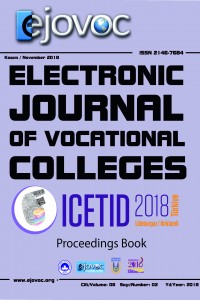Öz
Microfluidic devices
are currently replacing their macroscopic counterparts in many applications.
Controlling the mass transport in the microchannels mostly depends on material
used and channel geometry is the key parameter to improve flows speed, reaction
sensitivity and surface robustness. As the flow type in the microfluidic
channels is laminar, micro-mixers have been using to provide semi-turbulent
flow inside the microchannels. In this study, microfluidic molds were
fabricated by using 3D printing method and mixing phenomena was observed in
different microplatforms with and without micro-mixer geometries to understand
the underlying diffusion mechanism, which causes to mixing phenomena in the
microchannel.
Anahtar Kelimeler
Kaynakça
- Akay, S., Heils, R., Trieu, H. K., Smirnova, I., & Yesil-Celiktas, O. (2017). An injectable alginate-based hydrogel for microfluidic applications. Carbohydrate Polymers, 161, 228–234. https://doi.org/10.1016/j.carbpol.2017.01.004 Bhatia, S. N., & Ingber, D. E. (2014). Microfluidic organs-on-chips. Nature Biotechnology, 32(8), 760–772. https://doi.org/10.1038/nbt.2989 Erkal, J. L., Selimovic, A., Gross, B. C., Lockwood, S. Y., Walton, E. L., McNamara, S., … Spence, D. M. (2014). 3D printed microfluidic devices with integrated versatile and reusable electrodes. Lab on a Chip, 14(12), 2023–2032. https://doi.org/10.1039/c4lc00171k McCreedy, T. (2000). Fabrication techniques and materials commonly used for the production of microreactors and micro total analytical systems. TrAC - Trends in Analytical Chemistry, 19(6), 396–401. https://doi.org/10.1016/S0165-9936(99)00176-4 Ren, K., Chen, Y., & Wu, H. (2014). New materials for microfluidics in biology. Current Opinion in Biotechnology, 25, 78–85. https://doi.org/10.1016/j.copbio.2013.09.004 Saggiomo, V., & Velders, A. H. (2015). Simple 3D Printed Scaffold-Removal Method for the Fabrication of Intricate Microfluidic Devices. Advanced Science, 2(9), 1–5. https://doi.org/10.1002/advs.201500125 Shallan, A. I., Smejkal, P., Corban, M., Guijt, R. M., & Breadmore, M. C. (2014). Cost-effective three-dimensional printing of visibly transparent microchips within minutes. Analytical Chemistry, 86(6), 3124–3130. https://doi.org/10.1021/ac4041857
Öz
Microfluidic devices
are currently replacing their macroscopic counterparts in many applications.
Controlling the mass transport in the microchannels mostly depends on material
used and channel geometry is the key parameter to improve flows speed, reaction
sensitivity and surface robustness. As the flow type in the microfluidic
channels is laminar, micro-mixers have been using to provide semi-turbulent
flow inside the microchannels. In this study, microfluidic molds were
fabricated by using 3D printing method and mixing phenomena was observed in
different microplatforms with and without micro-mixer geometries to understand
the underlying diffusion mechanism, which causes to mixing phenomena in the
microchannel.
Anahtar Kelimeler
Kaynakça
- Akay, S., Heils, R., Trieu, H. K., Smirnova, I., & Yesil-Celiktas, O. (2017). An injectable alginate-based hydrogel for microfluidic applications. Carbohydrate Polymers, 161, 228–234. https://doi.org/10.1016/j.carbpol.2017.01.004 Bhatia, S. N., & Ingber, D. E. (2014). Microfluidic organs-on-chips. Nature Biotechnology, 32(8), 760–772. https://doi.org/10.1038/nbt.2989 Erkal, J. L., Selimovic, A., Gross, B. C., Lockwood, S. Y., Walton, E. L., McNamara, S., … Spence, D. M. (2014). 3D printed microfluidic devices with integrated versatile and reusable electrodes. Lab on a Chip, 14(12), 2023–2032. https://doi.org/10.1039/c4lc00171k McCreedy, T. (2000). Fabrication techniques and materials commonly used for the production of microreactors and micro total analytical systems. TrAC - Trends in Analytical Chemistry, 19(6), 396–401. https://doi.org/10.1016/S0165-9936(99)00176-4 Ren, K., Chen, Y., & Wu, H. (2014). New materials for microfluidics in biology. Current Opinion in Biotechnology, 25, 78–85. https://doi.org/10.1016/j.copbio.2013.09.004 Saggiomo, V., & Velders, A. H. (2015). Simple 3D Printed Scaffold-Removal Method for the Fabrication of Intricate Microfluidic Devices. Advanced Science, 2(9), 1–5. https://doi.org/10.1002/advs.201500125 Shallan, A. I., Smejkal, P., Corban, M., Guijt, R. M., & Breadmore, M. C. (2014). Cost-effective three-dimensional printing of visibly transparent microchips within minutes. Analytical Chemistry, 86(6), 3124–3130. https://doi.org/10.1021/ac4041857
Ayrıntılar
| Birincil Dil | İngilizce |
|---|---|
| Bölüm | Makaleler |
| Yazarlar | |
| Yayımlanma Tarihi | 30 Kasım 2018 |
| Gönderilme Tarihi | 7 Eylül 2018 |
| Yayımlandığı Sayı | Yıl 2018 Cilt: 8 Sayı: 2 |

